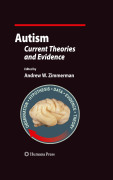
Creative thinking and collaborative scientific research have advanced our understanding of autism, and we are now beginning to synthesize the data into evidence and theories. Autism: Current Theories and Evidence presents current theories about autism and the evidence that supports them. The goal is to show how the scientific method is revealing the biological bases of this spectrum of disorders, thereby leading the way to their treatment and prevention using evidence-based medicine. This book has 20 chapters divided into 6 sections: Molecular and Clinical Genetics; Neurotransmitters and Cell Signaling; Endocrinology, Growth and Metabolism; Immunology, Maternal-Fetal Effects and Neuroinflammation; Neuroanatomy, Imaging and Neural networks; and Environmental Mechanisms and Models. The subjects cover a wide range of current scientific work in the field of autism, with strong and growing evidence to support them, and demonstrate both the breadth and depth of current autism research. A state-of-the-artsynthesis of credible biological theories of autism and the evidence that supports them Unique, evidence-based review of pathogenesis, clinical features, and current or potential treatments Wide-ranging, covering six main areas that probe and reveal the biological bases of autistic spectrum disorders INDICE: From the contents Engrailed and Cerebellar Development in the Pathogenesis of Autism Spectrum Disorders.- Teratogenic Alleles in Autism and Other Neurodevelopmental Disorders.- Cholesterol Deficit in Autism: Insights from Smith-Lemli-Opitz Syndrome.- Autism in Genetic Intellectual Disability: Insight into the Bases and Features of Idiopathic Autism.- Serotonin Dysfunction in Autism.- Excitotoxicity in Autism: The Role of Glutamate in Pathogenesis and Treatment.- Prenatal Beta 2 Adrenergic Receptor Signaling and Autism: Dysmaturation and Retained Fetal Function.- A role for fetal testosterone in human sex differences: Implications for Understanding autism.- Interaction between Genetic Vulnerability and Neurosteroids in Purkinje cells as a Possible Neurobiological Mechanism in Autism Spectrum Disorders.- Insulin-like growth factors: Neurobiological regulators of brain growth in autism?
- ISBN: 978-1-60327-488-3
- Editorial: Humana
- Encuadernacion: Cartoné
- Páginas: 570
- Fecha Publicación: 01/10/2008
- Nº Volúmenes: 1
- Idioma: Inglés
